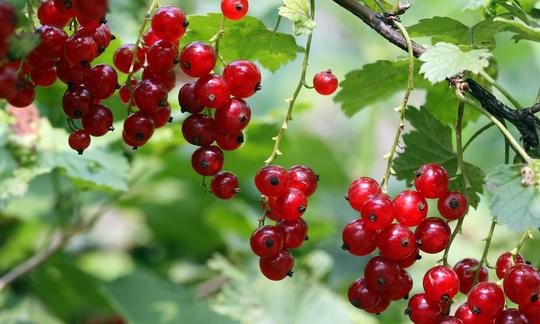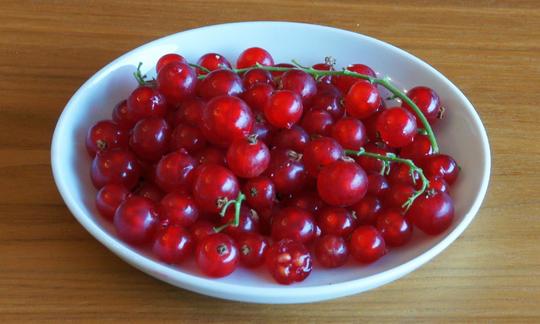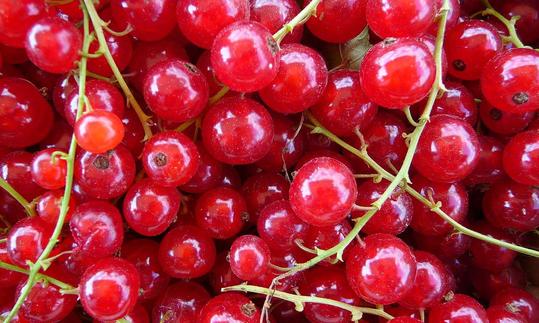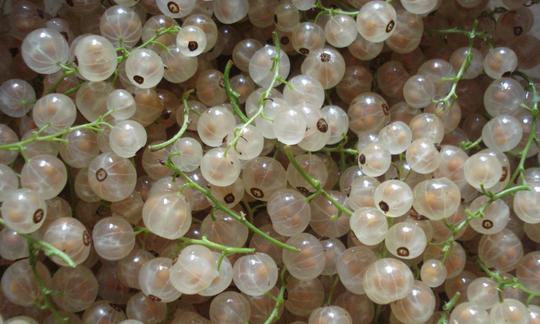Table of contents
Redness Blackcurrants ( Ribes rubrum), also known as red currants, can be eaten raw and pure (preferably organic) and are ideal for making desserts and adding to salads. White currants are simply a color variation of the red ones.
Use in the kitchen
Red currants, also called red currants or currants, are known for their sour-tart taste. The white currant, which is not a separate species but a color variation of the red currant ( Ribes rubrum), tastes a little less sour and milder. 2
Can you eat redcurrants raw? Raw redcurrants are a good seasonal, vitamin-rich raw food snack. They also taste great in refreshing water with lemon and peppermint, or their sour taste can be used to spice up morning muesli (e.g. pea muesli), all kinds of vegan desserts (e.g. creams, foam, cakes, muffins) or summer salads. Redcurrants are also ideal for making fruit slices.
Both varieties (red and white) can be used to make jam, marmalade, jelly or chutney, although red currants are far more popular due to their intense color. Currants gel optimally due to their high pectin content.
The berries can also be pressed to make juice. In the 18th century, blackcurrant juices (red and white) were in great demand at the Paris buffet. Blackcurrants can also be used to make wine. A blackcurrant wine made from white currants was also extremely popular at the time. 5
You can find out how to use black currants ( Ribes nigrum) in the corresponding article. Not only the fruits of both types of currant can be used in cooking, but also currant leaves.
Vegan recipe for redcurrant smoothie
Ingredients: 200 g redcurrants (raw, organic), 100 g apricots, 200 g freshly squeezed orange juice. Optional: 1 dash of lemon juice, 1 dash of agave syrup.
Preparation: Wash red currants and mix finely with rinsed, sliced apricots and freshly squeezed orange juice in a high-performance blender or smoothie maker. Add a splash of lemon juice and/or agave syrup to taste.
Smoothies can be varied with seasonal fruits depending on availability. Or you can mix vegan smoothies with rice or oat drink, which makes them creamier.
Tea preparation
Dried red currants can be brewed as a tea. Red currant tea is said to aid digestion. 4 1 tablespoon of dried berries is enough for a cup of tea. Red currant leaves are also suitable as a tea.
Vegan recipes with red currants can be found under the note: " Recipes that have the most of this ingredient ".
| Not only vegans or vegetarians should read this: Vegans often eat unhealthily. Avoidable nutritional errors. |
Purchasing - Storage
During the season, you can mainly get red currants from supermarket chains such as Coop, Migros, Denner, Spar, Aldi, Lidl, Rewe, Edeka, Hofer and Billa. The berries (in organic quality) can also be bought in organic supermarkets (e.g. Denn's Biomarkt, Alnatura). Smaller village shops (e.g. Volg) or supermarkets with regional ties offer currants from the surrounding areas - so it is also possible to get white currants.
Red currants have a season from June to August.
The availability of currants varies depending on the size of the store, catchment area, etc. Our recorded food prices for the DA-CH countries can be found above under the ingredient image - and by clicking on them you can see their development at various suppliers.
Found in the wild
A wild form of the red currant ( Ribes rubrum L. var. rubrum) can be found in Belgium, the Netherlands, France, Germany, Austria, Italy and Poland. It reproduces via creeping shoots. The leaves are shiny and wrinkled on the upper side, and the berries are small. 1.5
If you find the currant growing wild in the rest of Europe, it is usually a wild cultivated form ( Ribes rubrum var. domesticum WALLR.). For example, in Switzerland, where you can find the red berries cultivated as a berry bush or occasionally growing wild. 6
The main areas of distribution are alder and broadleaf alluvial forests. 4
The upright shrub (up to 1.5 meters high) has toothed, 3-5-lobed leaves and, unlike the black currant shrub, is odorless. From April to May the plant has small, green, hanging flowers. From the end of June or the beginning of July you can find round, shiny red, slightly transparent fruits on the shrub. 4.7
Storage tips
You can't store currants for very long. They only last a few days in the fridge. However, the berries last a very long time on the bush. If you have a currant bush, it's best to only pick them when you need them. Washed and well-dipped, they can also be frozen and thawed when you need them.
Ingredients - Nutritional values - Calories
Red currants (raw) have a calorie content of 56 kcal/100g. The main part is carbohydrates (14 g/100g; of which 7.4 g sugar) and fiber (4.3 g/100g). They contain hardly any fat (0.2 g/100g) and only a little protein (1.4 g/100g). 3
Their vitamin C content of 41 mg/100g (51% of the daily requirement) is comparable to that of mulberries (36 mg/100g). Blackcurrants contain significantly more of the vitamin at 181 mg/100g. 3
Raw red currants also contain vitamin K. The amount is 11 µg/100g (15% of the daily requirement). A similar amount can be found in mulberries (7.8 µg/100g) andraspberries (7.8 µg/100g). With 830 µg/100g, chard is an outstanding source of vitamin K. 3
Potassium is found in red currants (raw) at 275 mg per 100 g (14% of the daily requirement). Fresh goji berries (276 mg/100g) andblack elderberries (280 mg/100g) have similar amounts of the mineral. Dried herbs (eg parsley with 2680 mg/100g) are particularly rich in potassium. 3
Citric acid and malic acid are the main organic acids in red currants. Human taste perception (sweet or sour) is based more on the ratio of sugar to acids, rather than on the total sugar or acid content. This ratio can range from 1.9 (sour taste) to 4.3 (sweet) in red currants (red or white). 8
The complete ingredients of red currants, the coverage of the daily requirement and comparison values with other ingredients can be found in our nutrient tables. In the article Nutrients explained you will get a detailed insight into the topic.
Health effects
Red currants ( Ribes rubrum) are rich in a variety of health-promoting vitamins, minerals and organic acids. 9 They have, among other things, a mild laxative, diuretic, blood-purifying and digestive effect. Mineral salts and vitamin C promote the activation of the metabolism and strengthen the immune system. 4
Ribes rubrum also has anti-inflammatory and anti-platelet (i.e. antithrombotic) effects and may therefore be useful in the prevention and treatment of type 2 diabetes. 10
Red currant oil is also believed to have gastroprotective and antisecretory properties against stomach ulcers. It protects against mucosal damage through its antioxidant activity and its ability to maintain tissue and cell integrity. 11
Secondary plant substances
Many of the health effects of red currants can be attributed to the secondary plant substances they contain. Our article on secondary plant substances provides an overview of the classification of substance groups, their occurrence in foods and possible effects on humans. Red currants (including white varieties) contain the following secondary plant substances: 4,5,8,9,11,12
- Isosporenoids: Carotenoids (carotene, lutein), phytosterols
- Polyphenols: Phenolic acids (such as hydroxybenzoic acid, caffeic acid, p-coumaric acid), flavonoids (such as flavonols (quercetin), flavanols, anthocyanins (cyanidin)), condensed tannins (proanthocyanidins), hydrolysable tannins (ellagitannins, gallotannins)
However, it should be noted that the composition of secondary plant substances in red currants can vary depending on the variety, time of harvest and growing conditions. Therefore, quantities are only of limited use and should only be understood roughly.
Red currants ( Ribes rubrum) are a rich source of phytochemicals and antioxidants and are known for numerous health benefits. Consumption of these phytochemicals has been linked to the dietary treatment of diseases such as cancer, hypertension, osteoporosis and cardiovascular disease. Likewise, some studies have reported anti-inflammatory, antioxidant, antitumor and antimicrobial properties of Ribes species. 5,9
Many of the health benefits are due to the presence of phenols, particularly flavonoids. However, a number of factors can affect the flavonoid content of currants, including agricultural practices, environmental factors, ripening, processing, storage and cooking. 5
Although red currant contains about ten times less anthocyanins and two to three times less polyphenols than black currant, its superoxide radical scavenging activity (antioxidant activity) in vitro is almost as high as that of black currant extracts. 8
White currants are varieties of red currants. Their light color can be explained by a low content of anthocyanins. 12 Also interesting: flavonols are dominant in red currants, while hydroxybenzoic acids predominate in white currants. 8
The seeds contained in the berries contain a significant amount of valuable unsaturated fatty acids (alpha- and gamma-linolenic acid, oleic acid). Polyunsaturated fatty acids are quickly subject to oxidation, but are stabilized in the intact seeds, which indicates the presence of powerful natural antioxidants. 4,11
Dangers - Intolerances - Side Effects
No side effects are known for currants.
Risk of confusion
The berries of the red currant ( Ribes rubrum) can be confused with those of the common viburnum ( Viburnum opulus). These are slightly poisonous. The differences are that the viburnum berries lack a "tail" and their waxy and heavy texture. In addition, these fruits do not hang on the branches until September. 7,13
Currants should also not be confused with the red berries of the Daphne mezereum - these are also poisonous.
Folk medicine - natural healing
Freshly squeezed juice from currants is used as first aid for minor burns. 4 The berries were also used to relieve stomach problems. 5
Ecological footprint - animal welfare
The CO 2 footprint of a food depends on various aspects, such as cultivation method (conventional/organic), seasonality, country of origin, transport and, if applicable, packaging. According to the Danish climate database Concito, the carbon footprint of raw red currants is 0.69 kg CO 2 eq/kg. 14
According to a Dutch study from 2011, the water footprint amounts to 449 litres of water per 1 kg of currants (unspecific). 15
In conventional agriculture, synthetic insecticides and herbicides are often used to combat unwanted plants and insects. These have been proven to have a negative impact on the environment and affect important pollinators, birds and mammals. Accordingly, when buying red currants, you should buy organic products. This not only helps to preserve biodiversity, but also protects your own health (keyword: pesticide residues in conventionally grown currants) 16. The use of such pesticides is prohibited in organic farming.
For detailed explanations of various sustainability indicators (such as ecological footprint, CO2 footprint, water footprint), see our article: What does the ecological footprint mean?
Worldwide distribution - cultivation
The original distribution area of the red currant ( Ribes rubrum) is Western Europe. 17
The cultivation of red currants (with red and white coloring) probably began in the Netherlands and Denmark. Red currants were first cultivated as common garden plants in the 16th century in Holland, Denmark and the coastal plains around the Baltic Sea. 5 In the 18th century, the berries were introduced to North America. 8
Today, Russia, Poland, Ukraine, the United Kingdom and Germany are important growing countries for currants (unspecific). 18
Growing your own
currant bushes can be planted in the garden. They prefer deep, humus- and nutrient-rich soils in sunny to partially shaded locations. 19 The plants are well adapted to mild winters and wet summers - but they do not thrive in hot and dry climates. 8
Container plants can be planted all year round, but the best time is autumn or early spring. The planting hole should be filled with mature compost and the shoots of the plant should be cut back by two thirds after planting. In autumn, the plant can be fertilized by spreading rotting manure, nettle manure or wood chips on the surface. Regular mulching keeps the soil moist and protects the roots. 19
Because of their shootiness, careful annual pruning is important for a rich harvest. Red currant bushes are pruned differently than black ones. Red currants develop the most berries on short side shoots (two to three years old), while black currants produce the best harvest on one-year-old wood. 19
Most currants are ready for harvest between June and July - the time between flowering and ripening of the berries is on average 70 to 100 days, depending on the variety. The later you harvest currants, the sweeter they taste. 8.19
Further information
In addition to the red currant ( Ribes rubrum) and the black currant ( Ribes nigrum), the gooseberry ( Ribes uva-crispa) belongs to the genus of currants ( Ribes) within the gooseberry family ( Grossulariaceae ). The name originates from the ripening time around St. John's Day (24 June). 20
The white currant is a color variation or selection of the red currant and not a separate species. They therefore have the same botanical name, namely Ribus rubrum. However, the white berries are occasionally found under a separate species name - Ribus sativa. 2
Alternative names
Common names for currants in Germany are Ahlbeere, Gichtbeere, Träuble, Kanstraube or Gehonstraube. The Swiss know them as Trübeli or Meertrübeli and in Austria they are called Ribisel or Ribiseln.
In English, Ribes rubrum is known as red currant or redcurrant.
Other uses
Blackcurrant seeds, which are a by-product of juice production, are considered a valuable source of oil rich in polyunsaturated fatty acids. 5
Bibliography - 19 Sources (Link to the evidence)
| 2. | Mein schöner Garten. Weisse Johannisbeeren. 2021. |
| 3. | USDA United States Department of Agriculture. |
| 4. | Fleischhauer SG, Guthmann J, Spiegelberger R. Enzyklopädie Essbare Wildpflanzen. 2000 Pflanzen Mitteleuropas. AT Verlag: Aarau; 2013: 144-146. |
| 5. | Zdunić G, Šavikin K, Pljevljakušić D, Djordjević B. Chapter 5 - Black (Ribes nigrum L.) and Red Currant (Ribes rubrum L.) Cultivars. In: Simmonds MSJ, Preedy VR (Ed.) Nutritional Composition of Fruit Cultivars. 2016: 101-126. |
| 6. | Infoflora: Ribes rubrum L. |
| 7. | Mabey R. essbar: Wildpflanzen, Pilze, Muscheln für die Naturküche. Bern: Haupt Verlag; 2013: 170-171. |
| 8. | Kampuss K, Pedersen HL. A review of red and white currant (Ribes rubrum L.): research and literature. Small Fruits Review. 2003;2(3):23-46. |
| 9. | Rizwana H, Alwhibi MS et al. Sunlight-mediated green synthesis of silver nanoparticles using the berries of Ribes rubrum (Red currants): characterisation and evaluation of their antifungal and antibacterial activities. Molecules. 2022;27(7):2186. |
| 10. | Gülmez G, Şen A et al. The antioxidant, anti-inflammatory, and antiplatelet effects of Ribes rubrum L. fruit extract in the diabetic rats. J Food Biochem. 2022;46(7):e14124. |
| 11. | Elsadek MF, Almoajel A, Farahat MF. Ameliorative effects of Ribes rubrum oil against gastric ulcers caused by indomethacin in experimental models. Saudi J Biol Sci. 2022;29(1):30-34. |
| 12. | Zorenc Z, Veberic R et al. Polyphenol metabolism in differently colored cultivars of red currant (Ribes rubrum L.) through fruit ripening. Planta. 2017;246(2):217-226. |
| 13. | Bayerische Landesanstalt für Landwirtschaft. Gewöhnlicher Schneeball – Kurzbeschreibung heimischer Gehölze. |
| 14. | The Big Climata Database. Version 1.1. Currant, red. 2024. |
| 15. | Mekonnen MM, Hoekstra AY. The green, blue and grey water footprint of crops and derived crop products. Hydrol. Earth Syst. Sci. 2011;15:1577-1600. |
| 16. | Pini U. Das Bio-Food Handbuch. Ullmann Verlag: Potsdam; 2014: 352-353. |
| 17. | Royal Botanical Garden Kew. Plants of the World Online. Ribes rubrum L. |
| 18. | FAOSTAT Food and Agriculture Organization of the United Nations. Currants (Production Quantity 2022). |
| 19. | Mein schöner Garten. Johannisbeeren. 2023. |
| 20. | Botanikus. Johannisbeeren. |














Comments